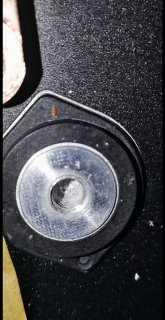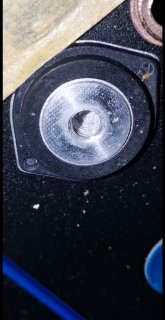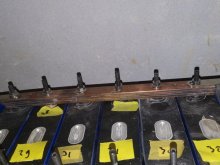Frank in Thailand
making mistakes so you don't have to...
Threaded rods are without doubt the best to use for cells.
The bolts / screws that get delivered with the cells go in the big bucket
I like to share with you the benefits for using locking agent (Loctite)
I have enough cells to test and play.
What I found is that when I use threaded rod in the terminal I can wiggle it slightly.
(Sorry for the simplified "Thaienglish" that's getting a nasty habit..)
This doesn't make me confident to really clamp tight the bus-bar to the terminal.(and i did strip one cell from it's thread)
Result: unstable voltage of the affected cells.
It starts OK but probably oxidation will make the contact worse over time.
Bad contact will make the cells seem to "run" faster to the top and faster to bottom, reduce by this the overall capacity.
(When the affected cell claims 100% full, the rest is at 80%, and when it's bottom the rest is at 20% roughly)
Many posts have been about possible contact loss due locking agent.
Where most of the contact should come from terminal and bus-bar, and the threaded rod play just a small part, it does play a part.
I've tested using the "YR1035+" internal resistance meter for LiFePO4.
No locking agent have 2.08 mili ohms between the terminal and (stainless steel) rod.
At the same hight measured, not yet dry agent give 1.04 and dry 0.8 mili ohms resistance.
I could not measure if the threaded rod without locking agent would reduce resistance when it's been pulled by a nut.
It would probably improve some.
I did kill one cell tighten too strong.
And the ones treated with Locking agent have been clamped more tightly then the one where the thread was pulled out.
It makes the contact strength so much better.
Just make sure your threaded rods are long enough for your mounting plans.
You won't be able to replace them.
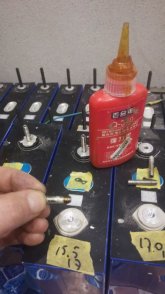

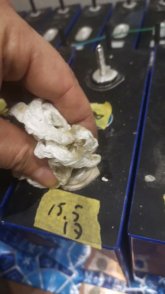
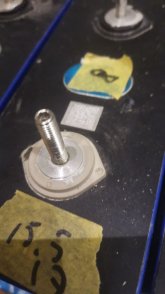
The bolts / screws that get delivered with the cells go in the big bucket
I like to share with you the benefits for using locking agent (Loctite)
I have enough cells to test and play.
What I found is that when I use threaded rod in the terminal I can wiggle it slightly.
This doesn't make me confident to really clamp tight the bus-bar to the terminal.(and i did strip one cell from it's thread)
Result: unstable voltage of the affected cells.
It starts OK but probably oxidation will make the contact worse over time.
Bad contact will make the cells seem to "run" faster to the top and faster to bottom, reduce by this the overall capacity.
(When the affected cell claims 100% full, the rest is at 80%, and when it's bottom the rest is at 20% roughly)
Many posts have been about possible contact loss due locking agent.
Where most of the contact should come from terminal and bus-bar, and the threaded rod play just a small part, it does play a part.
I've tested using the "YR1035+" internal resistance meter for LiFePO4.
No locking agent have 2.08 mili ohms between the terminal and (stainless steel) rod.
At the same hight measured, not yet dry agent give 1.04 and dry 0.8 mili ohms resistance.
I could not measure if the threaded rod without locking agent would reduce resistance when it's been pulled by a nut.
It would probably improve some.
I did kill one cell tighten too strong.
And the ones treated with Locking agent have been clamped more tightly then the one where the thread was pulled out.
It makes the contact strength so much better.
Just make sure your threaded rods are long enough for your mounting plans.
You won't be able to replace them.







